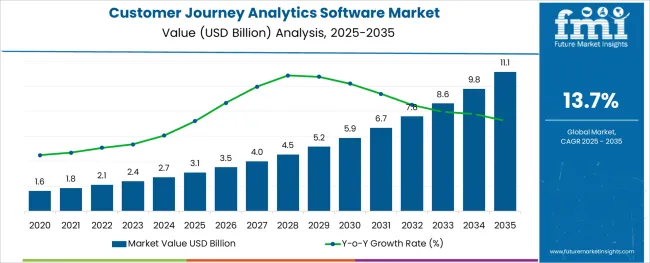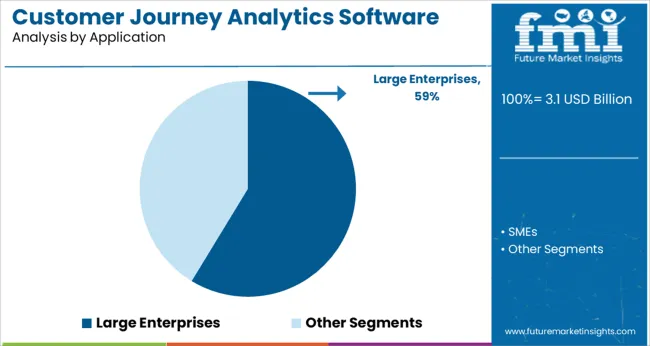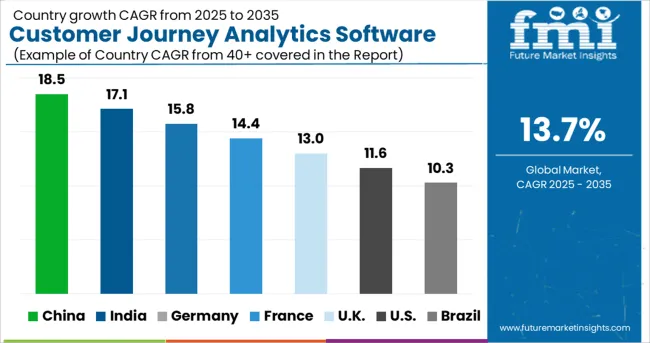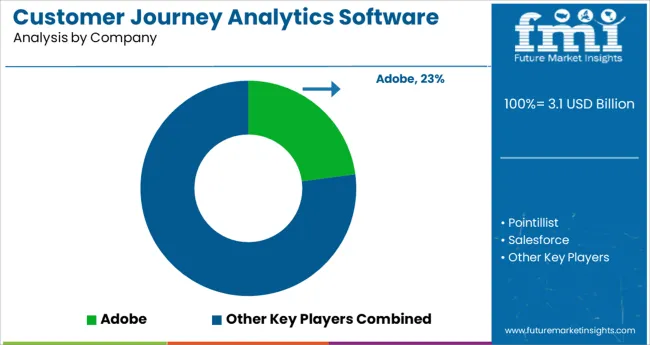The Customer Journey Analytics Software Market is estimated to be valued at USD 3.1 billion in 2025 and is projected to reach USD 11.1 billion by 2035, registering a compound annual growth rate (CAGR) of 13.7% over the forecast period.

The customer journey analytics software market is witnessing sustained expansion, driven by businesses' growing emphasis on delivering personalized and seamless customer experiences across multiple touchpoints. As digital transformation accelerates across industries, organizations are increasingly investing in advanced analytics platforms capable of tracking, integrating, and analyzing customer interactions in real time.
The market has gained momentum as enterprises recognize the commercial value of mapping comprehensive customer journeys to optimize marketing strategies, enhance customer retention, and improve service outcomes. Looking ahead, the market is expected to experience steady growth, propelled by heightened competition in the consumer-centric economy and the rising adoption of omnichannel engagement strategies.
Furthermore, technological advancements in artificial intelligence, machine learning, and predictive analytics are poised to elevate software capabilities, enabling businesses to anticipate customer behaviors and deliver contextually relevant engagements. Data privacy regulations and growing concerns over ethical data usage are also shaping the market, compelling software providers to prioritize transparent and compliant data management solutions. Collectively, these factors position customer journey analytics software as an indispensable tool in modern enterprise strategy frameworks.
The market is segmented by Type and Application and region. By Type, the market is divided into Cloud-Based and On-Premises. In terms of Application, the market is classified into Large Enterprises and SMEs. Regionally, the market is classified into North America, Latin America, Western Europe, Eastern Europe, Balkan & Baltic Countries, Russia & Belarus, Central Asia, East Asia, South Asia & Pacific, and the Middle East & Africa.

The cloud-based segment secured a commanding 63.5% share of the customer journey analytics software market, consolidating its position as the dominant deployment model within the type category. This leadership has been driven by enterprises’ increasing preference for scalable, flexible, and cost-efficient software solutions that support remote access and rapid deployment across diverse operational environments.
The cloud-based model offers seamless integration with existing CRM, marketing automation, and customer support platforms, allowing businesses to unify customer data streams and generate actionable insights without substantial infrastructure investments. Additionally, the growing importance of real-time analytics for immediate decision-making and personalized service delivery has made cloud-based solutions the preferred choice for both mid-sized and large organizations.
Continuous updates, enhanced data security protocols, and easy integration with AI and machine learning tools have further solidified this segment’s dominance. Moving forward, as hybrid work models and decentralized business operations persist, demand for cloud-based customer journey analytics platforms is expected to remain robust, supported by ongoing innovation and enterprise cloud migration strategies.

Within the application category, the large enterprises segment led the market with a 58.7% share, reflecting its significant investment capacity and early adoption of advanced analytics technologies. Large enterprises have consistently prioritized comprehensive customer journey analytics to refine their marketing, sales, and service strategies, leveraging these insights to enhance customer satisfaction and maximize lifetime value.
The segment’s growth is underpinned by its ability to handle vast, complex data sets generated from multiple touchpoints including web, mobile, social media, and in-store interactions. Additionally, heightened competition and increased customer expectations have compelled large enterprises to deploy sophisticated analytics tools capable of delivering granular insights and predictive models.
These organizations often operate across diverse geographical markets and product categories, necessitating advanced solutions that offer scalability, customization, and integration with enterprise-level IT ecosystems. Future demand within this segment is expected to be driven by increased focus on customer-centric growth strategies, heightened data governance requirements, and the expanding application of AI-driven analytics in enterprise decision-making processes.
Advancements in Digitization are expected to drive Market Growth
Data generated by centralized systems have been growing in volume as digitalization progresses. In recent years, the need for real-time data analysis, particularly in regard to e-commerce, has significantly increased. It's imperative that retailers and online merchants are accustomed to monitoring customer journey analytics solutions, as these can be used to monitor the overall customer experience across different channels and help retailers satisfy their customers.
By possessing a metric for measuring customer satisfaction, marketers and business owners are able to make better decisions to grow businesses in the market.
Consistent customer support across the entire customer journey is becoming increasingly crucial for business success. In recent years, businesses have been focusing heavily on creating analytics technologies in order to gain a high-level consumer base. Through traffic analytics and e-commerce analytics, customer journey analytics can be of assistance to these specific industries.
In order to make strategic decisions in an organization, information needs to be converted into digital form, which is expected to further drive the growth of the customer journey analytics market.
Modern techniques and analysis methods that can assist organizations in almost every sector to build stronger relationships with their customers are curtailed by the latest investments and strategies.
Retail and e-commerce businesses are increasingly turning to customer journey analytics solutions in order to stay up to date with the rapidly evolving expectations of customers through multiple channels, in real-time, and to guide them through the entire journey in order to meet their needs as they change.
Personalized Omni channel experiences are of high value to consumers today, but they also demand them in the retail market. Thus, there is a growing trend among retailers to leverage technologies to gain a deeper understanding of consumers' preferences through the use of customer analytics technologies.
Customer analytics has become increasingly important in retail as sales grow. This helps companies develop more personal communication and marketing strategies. Customer loyalty and experience are also enhanced by determining which buyers purchase which products and tailoring marketing to the specific preferences of those buyers.
A number is an important tool in evaluating and managing the efforts of every organization. The existence of complex technology and tools is also expected to hamper the growth of the IoT market in elevators. Customer experience leaders face the most difficult challenge of quantifying the return on investment that is generated by customer experience, but, for brands, it is most crucial to justify the financial results that are generated.
Businesses of all types struggle to link customer behavior to business-critical metrics, including revenue, retention, and customer service costs. A lack of tools and technologies is expected to slow the growth of the market in the near future. A budget for CX is difficult to secure when it is not possible to measure the impact on business outcomes. As a result budgets for CX initiatives in organizations struggling to quantify ROI have stagnated or decreased.
According to experts, security threats will be on the rise in the upcoming years. Security breaches and data loss have increased due to inefficiency in managing massive amounts of data and volumes of data in the market. This will likely hinder the growth of customer journey analytics software in the market.
In addition, a significant increase in data sources has caused several IT departments to have difficulty managing the data. An extensive number of graphical and text-based database files requires a significant amount of time, money, and human resources to analyze.
As a result, customer journey analytics creates issues that affect the optimum return on investment in such analytics. All these factors are likely to hinder the growth of customer journey analytics software in the market.
The market for large enterprises is expected to grow at a significant rate over the forecast period
Customer journey analytics applications will likely increase in demand in the market as enterprise adoption of the software continues to rise. The use of customer journey analytics software can provide many benefits to large enterprises that can be reaped.
The adoption rate of cloud computing among large enterprises is projected to increase at a tremendous rate, with a CAGR of 13.1%. In order to provide their clients with a better customer experience, large companies analyze the customer's journey in order to optimize their marketing and sales efforts. As a result, this data can also be used for improving their product offerings and business strategies.
Customer journey analytics software can provide enterprises with a wide range of benefits, including enhanced customer service, revenue growth, enhanced knowledge of the customers, improved marketing and sales efforts, enhanced product offerings, and increased sales in the market. Further, organizations spend a great deal of money on technological advancements in order to secure a larger share of the market in a highly competitive market.
Businesses are using predictive analytics to make accurate predictions about consumer buying preferences through the use of business intelligence solutions in the market. As part of the predictive analysis, different models are used to improve satisfaction with existing customers, prevent customer loss, and strengthen customer relationships.
Cloud-based Customer Journey Analytics Software Expected to Reign Supreme
The customer journey analytics market has been segmented into two categories based on top types on-premises and cloud-based. According to the forecast, the cloud segment is expected to grow at a rapid pace during this period. The availability of easy deployment options and minimal capital and time requirements can be attributed to the high CAGR of 13.6% in the cloud segment.
The acceleration of social distancing, online shopping, and the lockdown of COVID-19 have all contributed to the lockdown scenario, and are anticipated to drive the adoption of cloud-based customer journey analytics solutions.
Using a cloud-based customer journey analytics solution helps businesses improve their customer journey analytics by tracking, understanding, and optimizing their customers' journeys. Customer retention and loyalty can be improved as well as customer churn is reduced using these technologies.
SMEs with limited resources and time can use cloud-based customer journey analytics software since it is accessible to all businesses. Companies across the globe introduced work-from-home policies for their employees during covid-19, thus creating a market opportunity for companies to use cloud-based analytics solutions to manage critical information in the market.

Availability of new technology and expansion of business to broaden the scope of the North American market
As a result of the rapid adoption of new technologies and the presence of significant market players in this region, the market for customer journey analytics software market is likely to dominate in the near future. Increasingly, enterprises in this region see data collection, usage, and analysis as an opportunity to improve the customer experience in the market.
The USA is expected to generate a CAGR of 13.4% for customer journey analytics software during the forecast period. The majority of American companies will also continue to spend more money on marketing, yielding a moderate growth rate compared to the rest of the world.
As the growth of online applications has been spreading rapidly throughout the country, the USA has been identified as the region's biggest market for customer journey analytics. As a result of changing infrastructures and technological advancement in these regions, growth in customer journey analytics software is expected to continue to accelerate in the market.
China's Customer Journey Analytics Software Market is anticipated to grow impressively
As a result of the trend toward adopting customer journey analytics software, the Asia Pacific region is predicted to grow at the highest CAGR during the forecast period. As customer experience becomes more important in key countries like China, India, Japan, and Korea, more solutions and services focusing on customer journey analytics are expected to emerge in the coming years.
The commercialization of AI and machine learning techniques, which have a tendency to lead to a vast amount of data pertaining to customers, and the requirement to further advance this technology in order to realize its full potential is expected to increase the use of customer journey analytics software in the region.
It is expected that the Chinese market will represent the highest CAGR of 15.7% in the customer journey analytics software market for the forecast period.
Over the forecast period, Japan is projected to achieve a CAGR of 12.1% in 2035. South Korea's market is expected to grow by 11.2% CAGR over the next few years due to the increasing demand for cloud storage systems and the growth of SMEs in the region.
An increase in the number of industries adopting analytics software as well as an enormous rate of smartphone penetration is among other reasons for the growth of the customer journey analytics software market.
UK to emerge as the third largest country in the customer journey analytics software market
Due to the acceptance of emerging technologies, Europe ranks third in the customer journey analytics market. The customer journey analytics software market in the United Kingdom is projected to register a 12.6% CAGR during the forecast period.
The growth of e-commerce and retail sales in these regions will further drive customer journey analytics market growth. It is expected that the market will experience increased demand for digitization across different verticals in this region to continue to motivate their growth.

Adobe, Pointillist, Salesforce, Flockrush, Indicatie, Verint, CloudCherry, Cooladata, UXPressia, Alterian, and Auryc, among others are the top companies in the global customer journey analytics software market.
The main firms, which hold a substantial share of the customer journey analytics market, are concentrating on growing their customer base in new countries. To increase their profits and market share, these businesses rely on strategic collaboration initiatives.
As a result of technological advancements and product innovations, smaller and mid-sized businesses are expanding their market presence and entering new markets.
The global customer journey analytics software market is estimated to be valued at USD 3.1 billion in 2025.
It is projected to reach USD 11.1 billion by 2035.
The market is expected to grow at a 13.7% CAGR between 2025 and 2035.
The key product types are cloud-based and on-premises.
large enterprises segment is expected to dominate with a 58.7% industry share in 2025.






Full Research Suite comprises of:
Market outlook & trends analysis
Interviews & case studies
Strategic recommendations
Vendor profiles & capabilities analysis
5-year forecasts
8 regions and 60+ country-level data splits
Market segment data splits
12 months of continuous data updates
DELIVERED AS:
PDF EXCEL ONLINE
Customer Communications Management Market Size and Share Forecast Outlook 2025 to 2035
Customer Experience Management (CEM) In Telecommunication Market Size and Share Forecast Outlook 2025 to 2035
Customer Engagement Hub (CEH) Market Size and Share Forecast Outlook 2025 to 2035
Customer-Facing Technology Market Size and Share Forecast Outlook 2025 to 2035
Customer Experience Platforms Market by Interaction Points, Deployment, Enterprise Size, Region-Forecast through 2035
Customer Engagement Solutions Market Analysis - Demand & Growth through 2034
Customer Service Software Market Size and Share Forecast Outlook 2025 to 2035
Customer Advocacy Software Market - Enhancing Brand Loyalty
Customer Revenue Optimization (CRO) Software Market Size and Share Forecast Outlook 2025 to 2035
Customer-To-Customer (C2C) Community Marketing Software Market Size and Share Forecast Outlook 2025 to 2035
Customer Analytics in E-commerce Market by Component by Application & Region Forecast till 2035
Customer Journey Mapping Software Market Size and Share Forecast Outlook 2025 to 2035
Virtual Customer Premises Equipment Market Size and Share Forecast Outlook 2025 to 2035
Collaborative Customer Interfaces Market Analysis and Forecast 2025 to 2035, By Deployment Type, Type of User, End Use, and Region
Spending In Digital Customer Experience and Engagement Solutions Market Size and Share Forecast Outlook 2025 to 2035
Life Sciences Next-generation Customer Engagement Platforms Market Size and Share Forecast Outlook 2025 to 2035
Software-Defined Wide Area Network Market Size and Share Forecast Outlook 2025 to 2035
Software Defined Vehicle Market Size and Share Forecast Outlook 2025 to 2035
Software Defined Networking (SDN) And Network Function Virtualization (NFV) Market Size and Share Forecast Outlook 2025 to 2035
Software Defined Perimeter (SDP) Market Size and Share Forecast Outlook 2025 to 2035

Thank you!
You will receive an email from our Business Development Manager. Please be sure to check your SPAM/JUNK folder too.
Chat With
MaRIA